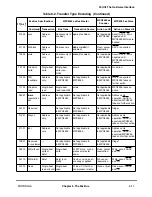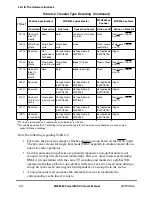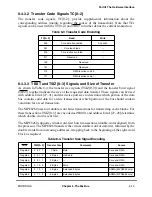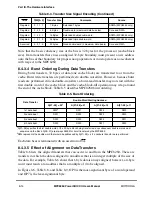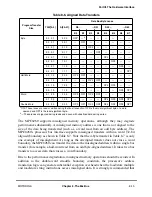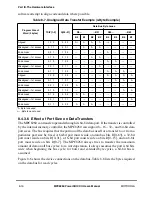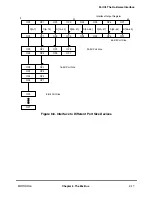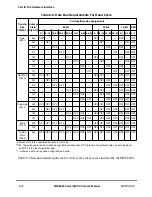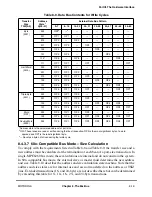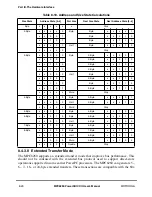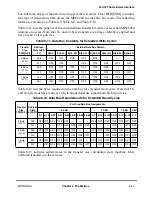
8-6
MPC8260 PowerQUICC II UserÕs Manual
MOTOROLA
Part III. The Hardware Interface
external central bus arbiter or by the internal on-chip arbiter. In the latter case, the system
is optimized for three external bus masters besides the MPC8260. The arbitration
conÞguration (external or internal) is determined at system reset by sampling conÞguration
pins. See Section 10.9, ÒExternal Master Support (60x-Compatible Mode),Ó for more
information.
The MPC8260 controls bus access through the bus request (BR) and bus grant (BG) signals.
It determines the state of the address and data bus busy signals by monitoring DBG, TS,
AACK, and TA, and it qualiÞes them with ABB and DBB.
The following signals are used for address bus arbitration:
¥
BR (bus request)ÑA device asserts BR to request address bus mastership.
¥
BG (bus grant)ÑAssertion indicates that a bus device may, with proper
qualiÞcation, assume mastership of the address bus. A qualiÞed bus grant occurs
when BG is asserted while ABB and ARTRY are negated.
¥
ABB (address bus busy)ÑA device asserts ABB to indicate it is the current address
bus master. Note that if all devices assert AACK with TS and would normally negate
ABB after AACK is asserted, the devices can ignore ABB because the MPC8260 can
internally generate ABB. The MPC8260Õs ABB, if enabled, must be tied to a pull-
up resistor.
The following signals are used for data bus arbitration:
¥
DBG (data bus grant)ÑIndicates that a bus device can, with the proper qualiÞcation,
assume data bus mastership. A qualiÞed data bus grant occurs when DBG is asserted
while DBB and ARTRY are negated.
¥
DBB (data bus busy)ÑAssertion by the device indicates that the device is the
current data bus master. The device master always assumes data bus mastership if it
needs the data bus and is given a qualiÞed data bus grant (see DBG). Note that if all
devices assert DBB in conjunction with qualiÞed data bus grant and would normally
negate DBB after the last TA is asserted, the devices can ignore DBB because the
MPC8260 can generate DBB internally. The MPC8260Õs DBB signal, if enabled,
must be tied to a pull-up resistor.
The following is a summary of rules for arbitration:
¥
Preference among devices is determined at the request level. The MPC8260 supports
eight levels of bus requests.
¥
When no bus device is requesting the address bus, the MPC8260 parks the device
selected in the arbiter conÞguration register on the bus.
For more information, see Section 4.3.2.2, Ò60x Bus Arbiter ConÞguration Register
(PPC_ACR).Ó
Summary of Contents for MPC8260 PowerQUICC II
Page 1: ...MPC8260UM D 4 1999 Rev 0 MPC8260 PowerQUICC II UserÕs Manual ª ª ...
Page 66: ...lxvi MPC8260 PowerQUICC II UserÕs Manual MOTOROLA ...
Page 88: ...1 18 MPC8260 PowerQUICC II UserÕs Manual MOTOROLA Part I Overview ...
Page 120: ...2 32 MPC8260 PowerQUICC II UserÕs Manual MOTOROLA Part I Overview ...
Page 138: ...Part II iv MPC8260 PowerQUICC II UserÕs Manual MOTOROLA Part II Configuration and Reset ...
Page 184: ...4 46 MPC8260 PowerQUICC II UserÕs Manual MOTOROLA Part II ConÞguration and Reset ...
Page 202: ...Part III vi MPC8260 PowerQUICC II UserÕs Manual MOTOROLA Part III The Hardware Interface ...
Page 266: ...8 34 MPC8260 PowerQUICC II UserÕs Manual MOTOROLA Part III The Hardware Interface ...
Page 382: ...10 106 MPC8260 PowerQUICC II UserÕs Manual MOTOROLA Part III The Hardware Interface ...
Page 392: ...11 10 MPC8260 PowerQUICC II UserÕs Manual MOTOROLA Part III The Hardware Interface ...
Page 430: ...Part IV viii MOTOROLA Part IV Communications Processor Module ...
Page 490: ...14 36 MPC8260 PowerQUICC II UserÕs Manual MOTOROLA Part IV Communications Processor Module ...
Page 524: ...17 10 MPC8260 PowerQUICC II UserÕs Manual MOTOROLA Part IV Communications Processor Module ...
Page 556: ...18 32 MPC8260 PowerQUICC II UserÕs Manual MOTOROLA Part IV Communications Processor Module ...
Page 584: ...19 28 MPC8260 PowerQUICC II UserÕs Manual MOTOROLA Part IV Communications Processor Module ...
Page 632: ...21 24 MPC8260 PowerQUICC II UserÕs Manual MOTOROLA Part IV Communications Processor Module ...
Page 652: ...22 20 MPC8260 PowerQUICC II UserÕs Manual MOTOROLA Part IV Communications Processor Module ...
Page 668: ...23 16 MPC8260 PowerQUICC II UserÕs Manual MOTOROLA Part IV Communications Processor Module ...
Page 758: ...27 28 MPC8260 PowerQUICC II UserÕs Manual MOTOROLA Part IV Communications Processor Module ...
Page 780: ...28 22 MPC8260 PowerQUICC II UserÕs Manual MOTOROLA Part IV Communications Processor Module ...
Page 874: ...29 94 MPC8260 PowerQUICC II UserÕs Manual MOTOROLA Part IV Communications Processor Module ...
Page 920: ...31 18 MPC8260 PowerQUICC II UserÕs Manual MOTOROLA Part IV Communications Processor Module ...
Page 980: ...A 4 MPC8260 PowerQUICC II UserÕs Manual MOTOROLA Appendixes ...
Page 1002: ...Index 22 MPC8260 PowerQUICC II UserÕs Manual MOTOROLA INDEX ...
Page 1006: ......




















